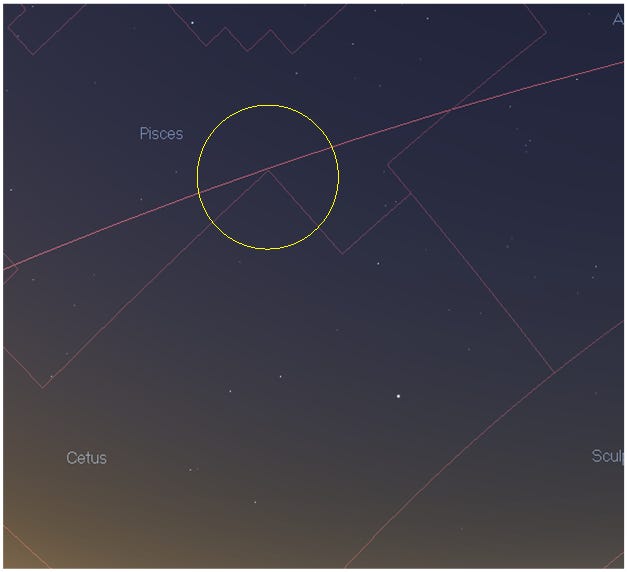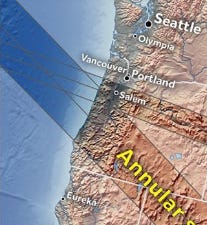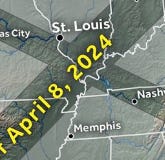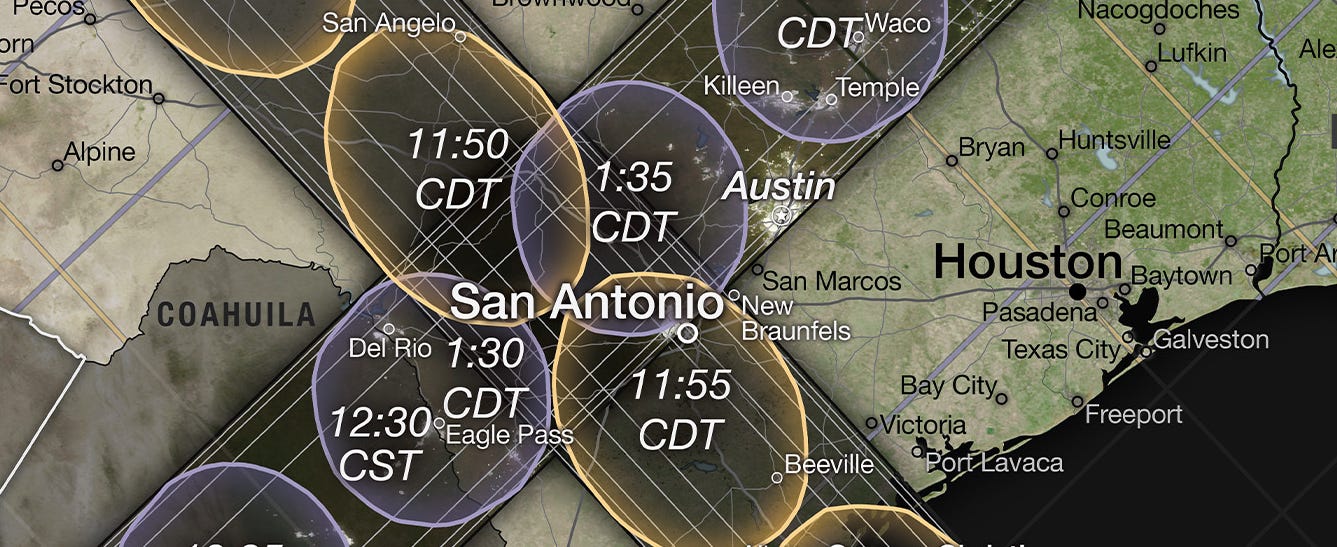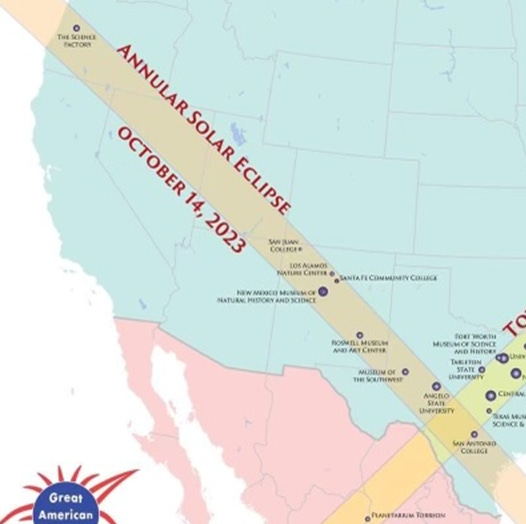#48 - Why Equinox Times Aren't Constant - Maps, Where to Go, and Things to Do Around October's Eclipses - 7 Total Stories [Free Post]
TCA 3/23/23: Teachniques--Equinox Times Don't Add Up, You Can Be Two Signs At Once; Sky Lessons--Mars' Magnitudes; Connections--Eclipse Maps and Overlaps, Side Trips; TCA on Hiatus+Survey w/Ecoupon!
Cover Photo - Measuring Mars’ Brightness
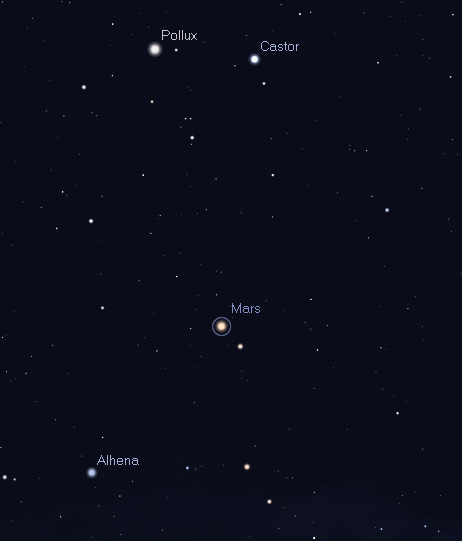
In This Issue:
Cover Photo - Measuring Mars’ Brightness
Welcome to Issue 48!
Personal Note and TCA Subscriptions Going on Hold
Astronomical Teachniques -
- Why Does the March Equinox Time Spring All Over the Clock?
- Lessons with A Half-Day Border CrossingSky Lesson - Magnitude and Color of Mars (Cover Story)
Connections to the Sky: The Upcoming Eclipses —
* New Maps of the Eclipses’ Paths
* Twice the Eclipses!
* Places to Visit While You Are There
The Classroom Astronomer Newsletter-Inbox Magazine #47 [Paid Post] Highlights
The Galactic Times Newsletter-Inbox Magazine Highlights #43
Welcome to The Classroom Astronomer Newsletter-Inbox Magazine #48 !
This is going to be the last issue of TCA for a while. As explained in the Personal Note below, I’m going to be offline for a ‘medical leave’ for a while and will be convalescing for some weeks. I hope to be catching up on writing books and there is a survey link attached to this newsletter in which you can make comments on book topics, and this newsletter, and even get some merch while I’m staring at the ceiling for that time! Wish me luck….I’ll have a lot of time on my hands….
And with that time thought in mind….
This issue contains a lot of stuff on time!
For example, you certainly heard about the Vernal Equinox earlier this week. Did you note the time it happened? Did it occur to you that it always changes? Did you notice that it doesn’t seem to ‘add up’ to an extra day? I inquired and got answers, and it would be an interesting discussion for your students.
Speaking of time, are you a Cetan? (Don’t be insulted….) If you were born on March 26th, you are either a Whale, a Monster, or a schizophrenic. Fortunately, I have only met two people with that birthday in my entire life! But if that fits you (the date, not the descriptions), then let me tell you why, and how you can use the date to teach your students some astronomy.
Planning to see the October eclipse? We have some new maps—closeups of the paths of the annular and totality zones, the overlap places where cities get to see TWO eclipses, and some planetariums holding public displays, or which you can add to your trip itinerary.
Finally, an easy, convenient, and timely observing task in the Sky Lessons article, monitoring Mars’ brightness as it passes across Gemini, with two stars of known brightness, Castor and Pollux. Mars starts as brighter than both, ends up fainter by end of May, so on which dates is it the same as the two stars?
- - -
Key websites: Homepage for The Classroom Astronomer, with its index to all Inbox Magazine issues’ contents, by celestial object, educational subject area, grade level or venue, and with complete Tables of Contents:
https://www.classroomastronomer.com . The ultimate home of our Universe — Hermograph Press — has its homepage at: www.hermograph.com and its Store, for educational materials and books, at: www.hermograph.com/store .
- - -
Thanks! Enjoy!
Publisher -- Dr. Larry Krumenaker
Personal Note and TCA Subscriptions Going on Hold
Getting right to the point, I am looking at a few months of surgical convalescence, beginning in ~2-3 weeks and lasting into June or possibly longer, and I am thinking of working on some books while I am mostly horizontal and immobile. Some of these are books already-in-progress; others are books I could start assembling from the mass of materials that have accumulated from two years of writing The Galactic Times and The Classroom Astronomer newsletters and five years of the TCA Magazines, many years of teaching, and even more articles written for others since the early 1990's.
To be most effective, I’d like to hear from you on what books (of the titles I’m thinking of) you think would be of interest to YOU, and which you think would be of interest to a larger audience of astronomy teachers or astronomy enthusiasts (or mass audiences). Of course I have my own ideas but it is good to have outside input.
The link below will send you to a completely anonymous survey, unless you’d like to leave your email address to be alerted when a book title becomes available for advance purchase at a discount. For a financial incentive, for completing the survey, even anonymously, you will earn a discount e-coupon worth 30% off purchases at the Hermograph Press Online Store, between now and April 25th! Books, educational materials, T-shirts, etc, on astronomy education and historical tourism!
This survey of 7 titles, plus one series of titles and one title with two formats, should take about ten minutes. Mostly, you only have to read the book descriptions and then click boxes if you think you or others would find the book worth buying/reading, and in what format(s), ebook and/or print book. Click any or all answers on each book; don't click any answers (i..e. skip them) if you don't find them of interest to you or think they won't be to others. There will be some tail-end other tasks—ranking some choices, a free comment box if you choose to make some on the books, newsletters, etc., and a choice to be notified if any of the books you like are finally available.
If you are interested in doing the Book Survey, click the link below. The survey will close on April 10th!
Thank you all again for being subscribers to The Classroom Astronomer and (hopefully) for taking the Survey. I will be deciding about TCA’s fate during my convalescence; meanwhile all paid subscriptions will be automatically put on hold as well, with renewals simply postponed while I am “on hold” as well <grin>.
Dr. Larry Krumenaker
Astronomical Teachniques -
Why Does the March Equinox Time Spring All Over the Clock?
You probably already noticed that the First Day of Spring (Northern Hemisphere)/Fall (Southern Hemisphere) occurred earlier this week. You might think any lesson with this is too late. Nope.
Try this out….
What time did the Vernal Equinox (sorry, Northern Hemisphere bias here) occur? We will use the official Universal Time (UT), i.e. time at Greenwich, UK, here, but if you like you can do the same thing for a future class (when does the summer solstice begin for your summer vacation in June, or winter solstice for Christmas break?, etc.) in local time.
In 2023, it was on the 20th (it virtually always is this date) at 21:24 UT.
In 2022, it was at 15:33 UT, some 5 hours and 51 minutes (5h 51m) earlier than in 2023. Hmmmm, why? Let’s explore further…
2021….9:37 UT, or 5h 54m earlier than last year.
2020….3:49 UT, or 5h 48m earlier still.
2019….10:58 UT!! Say, what??
2018….16:14 UT, or 5h 45m earlier from 2019, the anomalous year before.
2017….10:29 UT, 5h 59m earlier (what a jump UP!)
You can probably guess the 2019 to 2020 time shift was due to leap year, the addition of an extra day. Way back in primary school you learned every four years we add an extra day to keep to the calendar straight, and somewhere later on you had been taught that the real year takes 365 and a quarter day (6 hours) so every four years that quarter days add up to that extra day. It all makes sense, right?
Not quite.
The average change from year to year, minus the jump up in 2019, is 5 hours and 51 minutes, but the minute number ranges UP and DOWN from 45 to 59, a difference 6 to 8 minutes in either direction.
Why the bouncing numbers? And, why not exactly 6 hours?
Astronomers have several kinds of years. All but one are NEAR 365.25 days long. The Sidereal Year, measuring the passage of a fixed star to the passage of the same fixed star again a year later in the sky, is one. The Anomalistic Year is the time from one Earth perihelion to the next; that perihelion position slowly shifts over time due to planetary gravities pulling on us, and an extremely tiny relativistic influence. An Eclipse Year is (pardon the pun) anomalous; it goes from lunar node to lunar node and is only 346 days and some change.
What we actually use for the seasons is the Tropical Year. It goes from equinox to equinox and takes 365.242189 days. Notice….not quite a quarter day. That decimal part equals 5 hours and 48 minutes. Every four years we should have 23 hours and 12 minutes to add to the calendar. Our extra day, minus some change. Hmmmm. Well, we can talk about that another time.
But, we had an average of 5 hours and 51 minutes….and it wasn’t consistent! A Google search, plus a long look through my celestial mechanics books came up dry. So I went to the Time Lords—-the astronomers of the United States Naval Observatory and at the Royal Greenwich Observatory. I asked them…
Why isn't the average time between consecutive Vernal Equinoxes 5h 48 minutes?
Why is the interval between VE's varying in both up and down directions?
And, why is the VE in a pair of years four years apart, not the same time?
I first received a reply from Dr. Andrew Kopf, Astronomer & Production Lead of the Nautical Almanac Office there, and his answer was:
“After conferring with a couple colleagues yesterday, we think the answers to all three of those questions really have to do with the subtle influence of the other solar system bodies on the event. It is of course easiest to think about the equinox as being a two-body problem between the Earth and the Sun. However, the influence of the motion of Earth around the Earth-Moon barycenter, (Ed note: see barycenter definition in the figure caption.) while a small effect given the barycenter’s location, is not insignificant in this case. Additionally, the Moon, Sun, and other planets all place torques on the Earth, which cause nutation in obliquity and longitude.
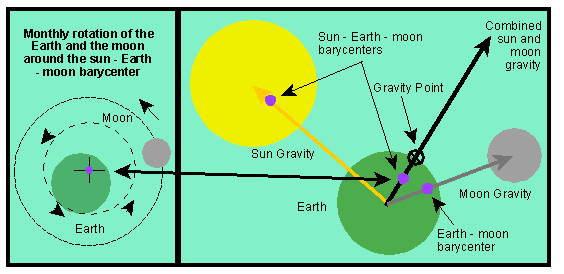
“Nutation, just in case you’re a bit less familiar on the topic, is a wavy wobble on the rotation axis as the Earth is orbiting the Sun, which is largely caused by the tidal forces of the Sun and Moon, though larger planets like Jupiter do also contribute small effects. This wobble causes a quasi-random effect on when the equinoxes and solstices occur, since there is not an even number of lunations (lunar months) in a tropical year. The result of nutation is that the exact position of Earth's equator becomes displaced from its mean position, and the equinoxes are then not equally spaced.
“One of my colleagues did a rough back-of-the-envelope calculation, which suggested that the Earth-Moon barycenter oscillation and nutation are several-arcsecond-level effects. This could each translate into several minutes of variation in when these events occur, probably more depending on the exact geometry. That, on the surface, seems to account for what you’ve calculated with the VE variation. It’s either that, or too many people are running marathons in the wrong direction and messing up the planet’s rotation 😉”
A later email came from a planetarium astronomer, Dr. Ed Bloomer, who noted that His Majesty’s Nautical Almanac Office was closed for some maintenance and the Curator of Time (!!!!) was unavailable. But the answer he gave was “the variation is caused by perturbations to the Earth’s motion due to the gravitational influence of other bodies in the Solar System, [Ed. note: That matches the USNO.] which can cause swings of, I believe, up to 25 minutes (I think that is an approximation, though I believe in 2042 will see a 23-minute shift), plus or minus. If the Earth’s orbit was perfectly Keplerian, we wouldn’t see this variation. I think in reality we’d have to account for small changes in axial precession too, although I’m not sure how strongly this correlates with the previously mentioned perturbations.”
So there you have it. This is, officially, why the time changes from year to year for an equinox (and presumably any equinox or solstice)...marathoners….okay, just kidding. The variable pulls of the different planets in different amounts each year, plus the fact that the Earth—Moon system does NOT have its balance point exactly in the middle of the Earth like diagrams tend to show in seasons diagrams in textbooks.
Have students research the next solstice or equinox times, and reason out that every four year jump (easy), that time change year to year value (no prob, teach’) and why does it vary (hmmmm) and why are they not the same and go up and down every year, or not the same every four years apart, or the same as the Tropical Day value (5h 48 minutes)—THAT should generate some interesting hypothesizing!
Lessons with A Half-Day Border Crossing
Circle the date! March 26, 2023. The date when the Sun dips its hot toes into a non-traditional Ecliptic constellation. Unlike all the other stars in our sky, the Sun is not a point of light — yes, yes, all the others are incredibly tiny disks but not enough to make a difference here—our Sun is a disk of about a half-degree in diameter. That disc’s center rides along the Ecliptic, that invisible line in the sky that mirrors the Earth’s orbit (and orbital plane). The constellations that the Ecliptic goes through make the zodiac constellations. Until a century ago, the constellations the Sun went THROUGH was all that mattered, but….in Humankind’s inevitable search for order, we divided up the sky into zones for each constellation, gave them borders like our nations (only we don’t see them encroach and try to conquer other constellations, but I digress….).
But that solar disc….as far as anyone is concerned it is where the *center* of the Sun is that makes a difference. If the center is in Aries, it doesn’t matter if part of the disc is in Pisces, we say the Sun is in Aries. Except, it does matter. Because THE PART OF THE SUN *ARE* in a constellation, not just its center. For all the Zodiacal constellations it doesn’t matter except for those few hours when the Sun is crossing a border. In fact, given that the Sun is a half-degree in diameter, and it averages a degree of movement per day, it doesn’t take too much math skill for a student to figure out how much of a day you have a change on a Border Crossing day you can be partly in one ‘sign’ and partly in another. [“Hi! I’m half-Ram and half-Bull!” Are you sure you aren’t totally Bull?” <sound of running feet>].
But….
Part of the border of Cetus the Whale comes right up to the line of the Ecliptic and touches it as a corner; in fact the border is a vertical AND a horizontal pair of lines that both touch ecliptic. The Sun’s center is, momentarily, in touch with both constellations, and the Sun’s disk is in BOTH constellations at the SAME time for some time. Some part of the Sun is partially in Cetus for about twelve hours….on March 26th (with some slight variation from year to year but we’ll skip on that technical issue).
That makes Cetus the 14th constellation of the zodiac. [What’s the 13th? Long-time TCA subscribers and others know…..Ophiuchus, The Serpent Bearer, which has the Sun wholly in it for more days than Scorpius does, but we digress again….].
In all the years I taught Astronomy 101 classes and labs, and we had discussions on coordinate systems and constellations, talking about the zodiac constellations was always a fun class, and always worth a small ‘bet’ that students didn’t really know their true zodiac signs. The die-hards always took my bet up. As the zodiac signs have shifted because of precession and the zodiac constellations aren’t ‘twelve equal sizes,’ only 1 out of 7 will find their astronomical signs match with their astrological ones. I always win the aggregate bet. But also it is the new knowledge of finding people with the sign of Ophiuchus that makes it educational and stick with them. Regrettably I think I have only maybe twice found a Cetan in all these years.
Sky Lesson - Magnitude and Color of Mars
Coming up in April, Mars leaves the Bull behind and enters the constellation of Gemini the Twins. The Red Planet actually makes a pretty good monitoring observational task for students for the month.
Mars, while bright, has lost a lot of its luster. It has faded to start the month of April as magnitude 1.0, end it as 1.3. When it leaves Gemini for Cancer in May, it will be mag 1.5.
Meanwhile, just above it in altitude (as in the celestial coordinate altitude, distance above the horizon, not height above the ground) are THE Twin stars, Pollux and Castor (see Cover Photo). Pollux is a spectral class K0 star, a bit towards the yellow-orange side, and mag 1.1. Castor is a multiple star system, with two bright, close stars separated by ~6-arc seconds, capable of being split in a decent small telescope at high enough power. Their combined light shines as a single bright blue or white A star of mag 1.6.
The task is to compare Mars’ magnitude to the two stars and determine what dates Mars matches first Pollux, and then Castor. A graph of the magnitudes would be extra credit! A color comparison of Mars with Pollux as it fades would be a secondary project.
Connections with the Sky: The Upcoming Eclipses
* New Maps of the 2023-24 Eclipse Paths
NASA has produced some finer detailed maps of the shadow paths of the October 2023 and April 2024 eclipses across the USA. In the online article at https://www.nasa.gov/feature/goddard/2023/sun/new-nasa-map-details-2023-and-2024-solar-eclipses-in-the-us there are several charts. The first one is the full nation-wide, very high-resolution chart showing both eclipses:
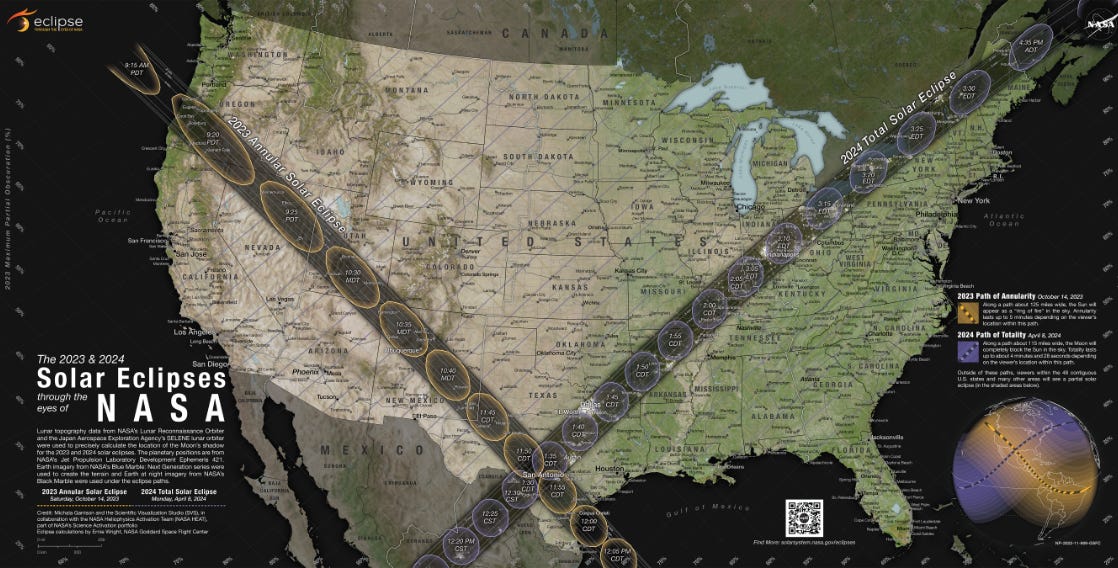
The site also includes a global map showing the full pathways from oceanic ends in the Pacific to those in the Atlantic. Other closer-in maps there include very detailed ones along the max center in Utah, along Lakes Erie and Ontario, and along southern Canada/northern New York and New England. There is also a close-up map where the two eclipse paths cross, in Texas (see below).
* Twice the Eclipses (and When Are the NEXT Ones?)!
These two eclipses are the second and third ones crossing the continent in recent years, the first being the total eclipse of 2017 that went from coast to coast. All three give the inhabitants of the whole North American continent three sets of partial eclipses to view! And all three tracks cross to make a triangle. A triangle has three corner points so an interesting idea to look up is….where are the three regions where two eclipses can be seen by the people living there?
The 2017 total eclipse crosses each of the future eclipse tracks—once. The first crossing is a ‘just barely’ patch on the extreme West Coast. The major overlap is actually over the Pacific Ocean, but there is a small triangle of Oregon where both eclipses could (have been) be seen. It is southwest of Salem, Oregon, and is roughly delineated by the cities of Lincoln City, Newport and Corvallis. Got any Oregonian friends?
The other 2017 overlap point crosses the 2024 eclipse path JUST north of the tri-state border point of Missouri, Illinois and Kentucky. Cape Girardeau and Carbondale are the largest cities in the diamond-shaped overlap zone. I’d be surprised if the hotels and campsites aren’t already booked, though the eclipse is still a year away.
That leaves the last triangle overlap zone, which concerns the 2023 and 2024 eclipse tracks. It is deep in the heart of Texas, southwest of Austin, west and northwest of San Antonio. In fact, the overlap zone (though not necessarily the eclipse(s)) misses all the big cities along I-10 or I-35. The most biggest and famous place in the overlap diamond is Kerrville, home of the Kerrville Folk Festival.
I used to live in Austin. I wonder if I have any of my old friends’ phone numbers somewhere…..?
By the way, after 2024, when are the next US eclipses? Do they cross these paths sometime? Soon? Nope. The next eclipses are in Alaska in 2039 and a total eclipse similar to the 2017 one, going from the west coast to Florida….in 2045.
* Places to Visit While You Are Eclipsing
A tweet from the website GreatAmericanEclipse.com, which has great stuff but from which I could not find this image, showed a map with planetariums along the path of the two upcoming eclipses. Here is a somewhat lower-res-than-desired look at the 2023 path showing what’s available. You can go to these places to join folks in a communal viewing or visit before or after as an extra astronomical treat while you are traveling.
In Oregon, in the path of the eclipse, is The Science Factory (Eugene).
In New Mexico, find a planetarium at San Juan College (Farmington), Los Alamos Nature Center (NW of Santa Fe), Santa Fe Community College, New Mexico Museum of Natural History and Science (Albuquerque), and Roswell Museum and Art Center.
In Texas, go to the Museum of the Southwest (Midland), Angelo State Universe (San Angelo), or San Antonio College.
The Classroom Astronomer Newsletter-Inbox Magazine #47 [Paid Post] Highlights
Cover Photo — Proof da Vinci Was Correct First
Welcome to Issue 47!
Gravity Rules! (A STEM Story) (Cover Story)
Connections to the Sky -
- Economic Impacts of Space
- Plasma Video
- The Science of the Sky—La Ciencia del CieloAstronomical Teachniques - Distances in the Universe: An Inquiry Lab Sequence Taught in West Africa and North America
- Recorded Workshops With Authentic DataThe RAP Sheet —
- Students’ Scientific Evaluations of Astronomical Origins
- The Method of Observation in Science Education:Characteristic Dimensions from an Educational Perspective
The Galactic Times Newsletter-Inbox Magazine Issue #43 Highlights
The Galactic Times Newsletter-Inbox Magazine #43 Highlights
Cover Photo — Moon and Planets on March 22nd
Welcome to Issue 43!
This Just In —
* The Glaciers of Mars
* Water in a Nebula
* Don’t Make Telescopes Without GlassesSky Planning Calendar —
* Moon-Gazing - Two Photo Nights with the Moon, A Planet and Stars (Cover Story)
* Observing—Plan-et - Planetary and Lunar Conjunctions
* For the Future—April’s Hybrid Eclipse; April Meteors
* Border Crossings - A Whale of a Crossing!Astronomy in Everyday Life - Earthliness in Universe Life?




